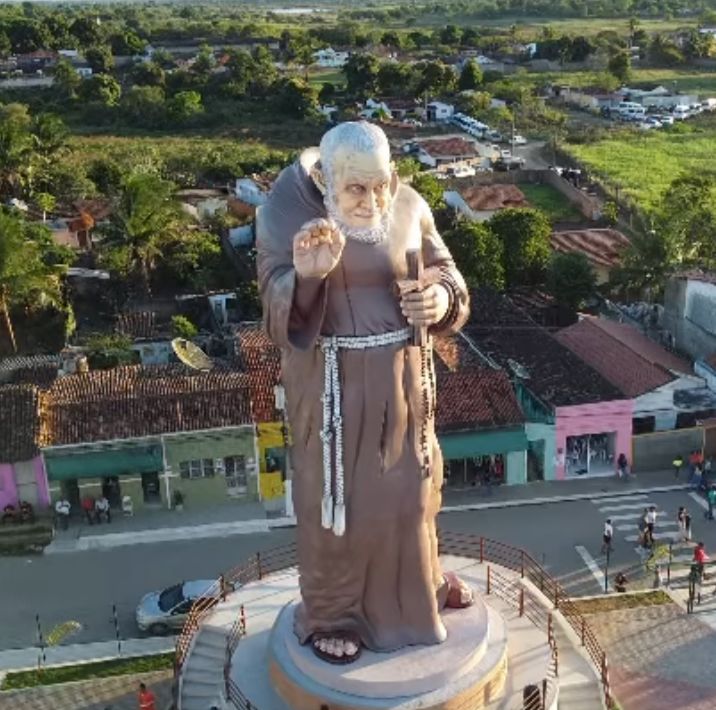SÃO PAULO – A 65-foot-tall sculpture of Frei Damião, a major folk saint in the Northeast of Brazil, was unveiled on November 14 in Canafístula, a district in the city of Palmeira dos Índios in Alagoas State.
Made of metal and shaped with high-density expanded polystyrene, polyurethane, and glass fiber, the piece is among the six tallest religious statues in Brazil.
There is a boom of giant sculptures of saints in the South American country. Earlier this year, a 141-foot-tall Jesus was unveiled in Encantado, in Rio Grande do Sul State. It is 16 feet taller than Rio de Janeiro’s famous Christ the Redeemer statue.
Several projects of similar nature are being carried out, as mayors all over the country wish to draw religious tourists to their cities.
“Our main idea was to enhance the cultural and religious significance of Canafístula, given that thousands of pilgrims come here every year,” said Cássio Ferreira da Silva, Palmeira dos Índios’s Cultural Secretary.
“But we also wanted to expand the religious tourism in the city. We had to revitalize the central square in order to welcome the pilgrims in a more adequate way,” he told Crux.
Italian-born Capuchin Father Damião of Bozzano came to Brazil in 1931 and lived in Recife, Pernambuco State. He soon began to travel all over the Northeast part of the nation performing missions, during which he would spend a few days in faraway locations celebrating Masses, administering the sacraments, and visiting prisoners and sick people. He is commonly called Frei Damião, with “Frei” meaning “Friar” in Portuguese.

He quickly gained the reputation of a holy man, and many people would travel several miles by foot to see him. Devotees attributed miracles to him, and he was seen as the successor of another folk saint in the Northeast, Father Cícero Romão Batista (known as Padim Ciço), who died in 1934.
As he grew old, a serious orthopedic condition – a combination of kyphosis and scoliosis – led to growing physical difficulties. He died in 1997, that the age of 98.
Many of his missions in Alagoas began in Canafístula, explained Father José Paulo da Costa, in charge of the local church.
“When he visited Canafístula, people would always come here to meet with him. That is how the tradition of making homages to him here began,” he told Crux.
Every year, pilgrims from Alagoas and the neighboring states visit the district in May, when Damião died, and in November, the month when he was born. Such pilgrimages may gather more than 30,000 people.
Visitants usually go to the local church and the house where he stayed. Another major point to see is a spring from which salt water used to flow.
“After Father Damião blessed it, as the story goes, it began to produce fresh water,” da Silva said.
The new sanctuary took about a year to finish. It was inaugurated exactly 30 years after Damião’s last mission to Canafístula. The opening ceremony was attended by more than 20,000 people.
Ranilson Viana, the sculptor who created the statue, tried to capture one of Frei Damião’s particular gestures, an upright posture he would assume when he blessed churchgoers.
“It has a slight waist rotation and is supported by the right leg. I did not want to overemphasize his curvature,” he told Crux.
Viana studied several of Frei Damião’s pictures and videos in order to design the image. Bu he was not unfamiliar with him.
“I lost my mother at an early age and was raised by my grandmother, who was a devotee of Father Damião. She was very happy about my work,” he said.
The statue was produced in five parts at Viana’s studio in Petrolina, in Pernambuco State.
“The pieces were carried by trucks for 370 miles. We stopped in every city along the way and people were already waiting for us to see and touch the sculpture. It was very moving to see all that,” he said.
When he was assembling the pieces, pilgrims already began to arrive in Canafístula.
“People were already thanking Father Damião for graces they received. An old lady asked me during the process where she should leave her donation,” Viana said.
He recently worked on a 75-foot-tall Heart of Jesus in Limoeiro de Anadia, Alagoas, and on a 65-foot-tall Our Lady of the Conception in Cabrobó, Pernambuco. He is also involved in projects to create giant sculptures of Frei Damião in two other cities in Alagoas.
“Those sanctuaries will form a route of pilgrimage. That is a region where people are much devoted to Frei Damião and have always wanted to celebrate his memory and to point out the places where he acted,” he said.
In the city of Guarabira, Paraíba State, there is a giant statue of him since 2004.
“I think that the new sanctuary will strengthen the pilgrimage to Canafístula. It was a very positive initiative,” da Costa said.
As a boy, he would leave the small city of Olivença and travel to Santana do Ipanema with his parents every time Frei Damião visited the region.
“We at times arrived at 6 pm and would hear him preaching till midnight,” he recalled. “He was a reference for us and led us to wish to go to the seminary,” da Costa added.
In 1997, when he was already a deacon, he took part in Frei Damião’s funeral mass. “I was ordained at the end of that year,” he said.
The numerous miracles attributed to Frei Damião are currently being catalogued and studied by a church commission. In 2019, he was recognized as venerable, and the process of his beatification is advancing.
“He was a strong figure, a small Capuchin friar full of devotion. People saw him as saint due to his remarkable fidelity to God’s word,” da Costa said.














